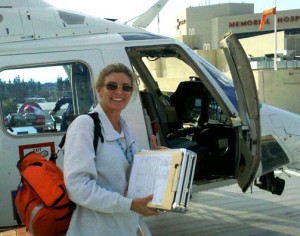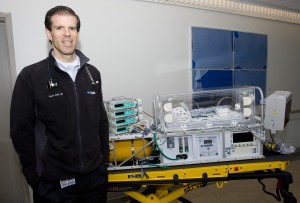Nurse Jill Palechek begins her 12-hour shift at 7 a.m. in the emergency and pediatric intensive care unit at Ronald Reagan UCLA Medical Center.
After what seems like an uneventful day of routine rounds, her pager suddenly buzzes. She rushes to meet a small team of colleagues, wondering if she might be hundreds of miles away from Los Angeles in a matter of hours.
The UCLA pediatric transport team is made up of nurses, emergency technicians, doctors and respiratory therapists who are specially trained to bring patients to Ronald Reagan UCLA Medical Center with the hopes of providing the patient with the best chance of survival.

On call
Depending on the distance, traffic conditions and weather, the transport team will decide whether to use a helicopter, plane or ambulance, said Joyce Keeler, a nurse on the team.
“The job can get pretty intense because as you plan, you know that time is of the essence,” Palechek said. “Sometimes we need to get to a newborn and we have a six-hour window to do what we need to do.”
On average the team makes about 15 transports a month, said Dr. Robert Kelly, medical director of pediatric transport for Ronald Reagan UCLA Medical Center.
In a typical neonatal transport helicopter call, the nurse, respiratory therapist and perhaps a physician – depending on the status of the patient – arrive at the outside hospital and arrange for the trip to Ronald Reagan UCLA Medical Center.
To be a member of the pediatric transport team, nurses and respiratory therapists must have at least two years of neonatal intensive care unit experience, as well as general adult intensive care experience, said Hratch Kayichian, a respiratory therapist. They then train for another two or three years in other areas and spend a few months learning how to stabilize a patient on a helicopter.
The respiratory therapist works with nurses who plan the transport and make judgment calls if a doctor is not there, Palechek said.
“(What) I really like about transports is the camaraderie of the team. We’re all focused on one goal and we share a common mission,” Kelly said. “We all love the jobs that we do. That part I enjoy almost as much as taking care of the patient.”
In some instances, the transport team will fly to retrieve a patient from a distance like Las Vegas or Fresno, Calif., and not get back until 3 a.m., said Kimberly Snow, a flight nurse.
“You’re in the helicopter and you haven’t eaten and you can’t go to the bathroom,” Snow said. “But at the end of the day, it’s just so rewarding.”
For a 2 month-old boy diagnosed with a critical heart condition, immediate surgery was the only option.
“When your child or family member is in a crisis and being transported, every minute counts,” said Rayme Elliot, the mother of the boy who was transported to Ronald Reagan UCLA Medical Center. “So to have that helicopter available … they’re like little angels for you.”
During trips to Ronald Reagan UCLA Medical Center, babies weighing less than 11 pounds are transported in a metal and plastic system called an isolette.
Unlike the previous isolette, the new model can fit into a helicopter, an ambulance or a plane without any modifications or assembly, Kelly said. The UCLA transport team is the first that they know of to have such a device that’s interchangeable, he added.
UCLA worked with REACH, the helicopter company the team switched to five years ago, to design an isolette that was able to safely transport the patient and fit inside of the REACH helicopter.
The isolette includes capabilities for cardiac and respiratory monitoring, a built-in ventilator and a warming system, which keeps babies protected from elements such as temperature fluctuations, changing pressure due to helicopter altitude, noises in the environment and rain.

Measuring the risk
When the team gets a call, the REACH helicopter pilot at the Upland Fire Department check the weather conditions and approve the transport, said Patty Murphy, a flight nurse for Upland.
Then, the pilot and an Upland flight nurse pick up the UCLA team for the call.
Most of the transports come from distant areas such as Bakersfield, Calif. or Emerald Valley, Calif., where hospitals don’t have the range of subspecialists that are available at places like UCLA, said Dr. Caroline Gibson, a neonatologist at Ronald Reagan UCLA Medical Center who assists in medical transports.
Other transports have flown to places such as Nevada, Hawaii and Arizona to pick up patients.
Typically, patients using the isolette are babies who have one of three conditions: a congenital heart defect, respiratory failure or a traumatic birth, such as being deprived of oxygen in the birthing process. However, all transports with babies under 11 pounds require the use of the isolette.
After their demanding shifts, transport team members need a few days to recover from their travels.
They are typically scheduled to work two days out of the week, giving them the time to catch up on much needed sleep.
Members of the transport team participate in routine mock simulations to prepare for possible emergencies.
Some team members use dummies that respond to treatment like real humans, and others watch from behind a wall and critique their performance.
“Your resources are only as good as your level of training,” said Ann McNeil, the pediatric and neonatal transport director.
Yet no matter how prepared they are, the transport team members must be ready to tackle unpredictability in an emergency.
“I’ve been doing hundreds of transports and we still never really know what we’re walking into,” Kelly said. “There’s a bit of anxiety on that end.”
Once, a ventilator wasn’t working properly during a transport and a respiratory therapist had to use a hand-bag to help the patient breathe all the way back to the hospital, Palechek said.
No matter how much training the team may have, there are times when the patient is too unstable to bring to the hospital or dies on the way.
“I ask myself, ‘Could I have done something different or better?’ But we know our team has done everything we could for the patient, even if that means seeing them for only five minutes,” Palechek said.
Gibson said she has seen changes to transport protocol, such as increased precautions, in recent years. During her residency, a transport team was killed when the helicopter crashed, prompting review and new regulations of transport procedures. For that reason, transport teams like UCLA’s evaluate the entirety of the situation before deciding whether or not to take a helicopter.
Despite the rigorous nature of the job, members of the team said they are fueled by the belief that they are making a difference in people’s lives.
“It’s a very physical job and after the transport I know I need to take my few Advils,” Kayichian said, laughing. “But I get a lot of satisfaction knowing that my team is bringing happiness to a lot of families.”

This is a very special breed. Those that put others first, no matter the circumstance or danger. We should all be greatful.
JC.